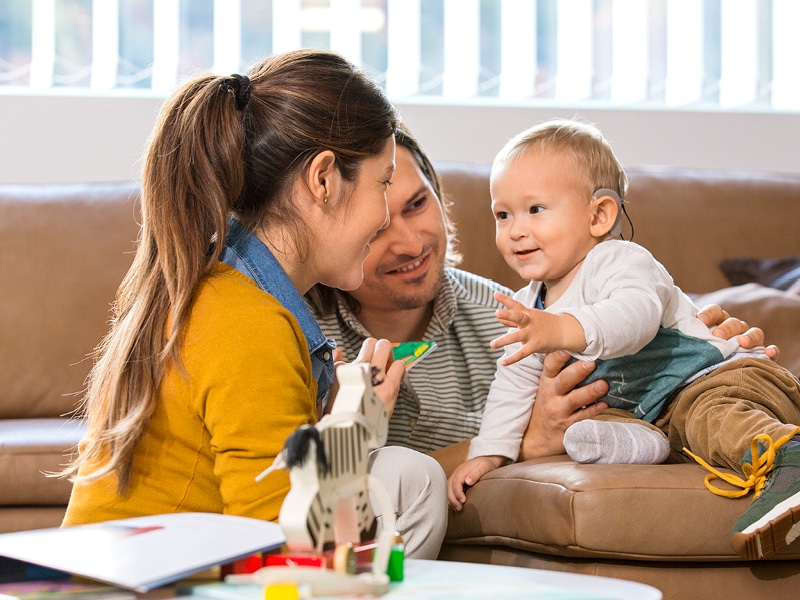
Donna Sperandio
Published Sep 06, 2023
Factors Affecting Communication Outcomes in Pediatric Cochlear Implantation
What factors affect communication outcomes in pediatric cochlear implantation? Research has revealed that age at implantation, family environment, additional disabilities, communication mode, and technological and surgical factors can all influence outcomes.

Cochlear implants have been provided to children with severe or profound deafness for many years. Recently, more has been learned about the outcomes following implantation and the factors that affect communication outcomes in pediatric cochlear implantation. This information is crucial for professionals to be aware of, both for the times in which they counsel parents before their child receives a cochlear implant, and to design rehabilitation programs that follow implantation.
This article relies heavily on information from two widely regarded recent research projects that have examined outcomes in pediatric cochlear implantation: The Childhood Development after Cochlear Implantation (CDaCI) study, and the Australian Longitudinal Outcomes of Children with Hearing Impairment (LOCHI) study.[5,1]
Age at Implantation
Age at implantation is a variable found to be very important in the outcome of children with cochlear implants.[1,2,3,4]
Teresa Ching and her colleagues at the LOCHI study found that when a child reached the age of 3 years, age at implantation was of immense importance.[2] When these children were studied again at the age of 5 years, the same result was found.[1] It has been shown that children who receive a cochlear implant before the age of 12 months achieve significantly better listening and spoken language outcomes.[3]
This population-based longitudinal study included more than 450 children with permanent hearing loss. The study found that the subset of children who received their cochlear implant before the age of 12 months had significantly higher language scores in standardized tests than children who received their cochlear implant later than 12 months of age. The same result was found for speech production skills.
Family Environment
The family environment is a crucial factor in outcomes following cochlear implantation. Improved language progress has been associated with higher levels of maternal sensitivity.[5] The LOCHI study has reported that maternal level of education led to improved outcomes for children.[1,2] This may be because higher educated parents have greater resources to find the most suitable services available, and they may provide increased quantity and quality of linguistic input.
Additional Disabilities
It is generally accepted that between 30 and 40 percent of children with hearing loss have additional disabilities.[1,6,8,9] Poorer outcomes in language development are reported for children who have multiple disabilities. Children with developmental delays, particularly autism spectrum disorder, cerebral palsy, and other neurological deficits associated with conditions such as cytomegalovirus (CMV), are more likely to have poorer language outcomes.[1,6] The provision of cochlear implants at an earlier age, family environment, and communication mode also led to improved language outcomes for this population, and cochlear implantation can provide benefits for these children.[11]
Communication Mode
The key studies mentioned both explored the effect of communication mode used by the child’s caregivers and outcome in spoken language development. These studies, and others, found better listening and spoken language outcomes for children who were surrounded by spoken language.[1,2,10]
Technological & Surgical Factors
Several technological factors related to the capabilities of the cochlear implant and audio processor should also be considered. Find more on the technological factors to consider to reach closest to natural hearing here, and details related to surgical factors and reliable electrode insertion such as scala tympani placement, tip fold-over, scalar deviation, and speech perception scores here.
Factors Affecting Communication Outcomes in Pediatric Cochlear Implantation: Implications for Professionals
Earlier age is better for intervention and for the provision of cochlear implants where needed.
Rehabilitation following implantation should focus on the support and education of the parents and extended network around each child. The MED-EL Lesson Kits, Remote Lesson Kits, Lesson Kits for Babies, and Ready, Steady, Go! all provide guidance for professionals to support caregiver coaching and education.
If the desired outcome for a child following implantation is spoken language, exposure to quality spoken language, rather than sign language, is suggested.[1,2,10]
Resources to support early intervention in spoken language for families of children with cochlear implants can be found on the MED-EL rehabilitation downloads page.
References
- Ching, T.Y., Dillon, H., Leigh, G., & Cupples, L. (2018). Learning from the longitudinal outcomes of children with hearing impairment (LOCHI) study: summary of 5-year findings and implications. International Journal of Audiology, 57(2), S105-S111.
- Ching, T. Y., Dillon, H., Marnane, V., Hou, S., Day, J., Seeto, M., . . . Yeh, A. (2013). Outcomes of early- and late-identified children at 3 years of age: findings from a prospective population-based study. Ear Hear, 34(5), 535-552.
- Dettman, S., Dowell, R. Choo, D., Arnott, W., Abrahams, Y., Davis, A., . . . Briggs, R.J. (2016). Long-term communication outcomes for children receiving cochlear implants younger than 12 months: A multicenter study. Otology and Neurotology, 37(2), e82-95.
- Leigh, J.R., Dettman, S.J., & Dowell, R.C. (2016). Evidence-based guidelines for recommending cochlear implantation for young children: audiological criteria and optimizing age at implantation. International Journal of Audiology,55, S9-S18.
- Quittner, A. L., Cruz, I., Barker, D. H., Tobey, E., Eisenberg, L. S., Niparko, J. K., & Childhood Development after Cochlear Implantation Investigative Team (2013). Effects of maternal sensitivity and cognitive and linguistic stimulation on cochlear implant users’ language development over four years. The Journal of pediatrics, 162(2), 343–8.e3.
- Cupples, L., Ching, T.Y.C., Button, L., Leigh, G., Marnane, V., Whitfield, J.,…Martin, L (2018). Language and speech outcomes of children with hearing loss and additional disabilities: identifying the variables that influence performance at five years of age. International Journal of Audiology, 57(2), S93-S104.
- Dettman, S., Dowell, R. Choo, D., Arnott, W., Abrahams, Y., Davis, A., . . . Briggs, R.J. (2016). Long-term communication outcomes for children receiving cochlear implants younger than 12 months: A multicenter study. Otology and Neurotology, 37(2), e82-95.
- Gallaudet Research Institute. (2011). Regional and national summary report of data from 2009-10 annual survey of deaf and heard of hearing children and youth. Washington, DC: GRI, Gallaudet University. Retrieved from http://research.gallaudet.edu
- Picard, M. (2004). Children with permanent hearing loss and associated disabilities: revisiting current epidemiological data and causes of deafness. Volta Review, 104. 221-236.
- Dettman, S., Wall, E., Constantinescu, G., & Dowell, R. (2013). Communication outcomes for groups of children using cochlear implants enrolled in auditory-verbal therapy, aural-oral, and bilingual-bicultural early intervention programs. Otology and Neurotology, 34, 451-459.
- Oghalai, J., Bortfeld, H., Feldman, H., Chimalakonda, N., Emery, C., Choi, J., & Zhou, S. (2022). Cochlear Implants for Deaf Children with Early Developmental Impairment. Pediatrics, 149 (6).
References

Donna Sperandio
Donna Sperandio is a Teacher of the Deaf and a Senior Rehabilitation Manager at MED-EL. She provides training and mentoring support for professionals working in the field of hearing loss and hearing implants, mainly in the Southeast Asia region.
Was this article helpful?
Thanks for your feedback.
Sign up for newsletter below for more.
Thanks for your feedback.
Please leave your message below.
CTA Form Success Message
Send us a message
Field is required
John Doe
Field is required
name@mail.com
Field is required
What do you think?
The content on this website is for general informational purposes only and should not be taken as medical advice. Please contact your doctor or hearing specialist to learn what type of hearing solution is suitable for your specific needs. Not all products, features, or indications shown are approved in all countries.

Donna Sperandio
Donna Sperandio is a Teacher of the Deaf and a Senior Rehabilitation Manager at MED-EL. She provides training and mentoring support for professionals working in the field of hearing loss and hearing implants, mainly in the Southeast Asia region.

Donna Sperandio
Donna Sperandio is a Teacher of the Deaf and a Senior Rehabilitation Manager at MED-EL. She provides training and mentoring support for professionals working in the field of hearing loss and hearing implants, mainly in the Southeast Asia region.



